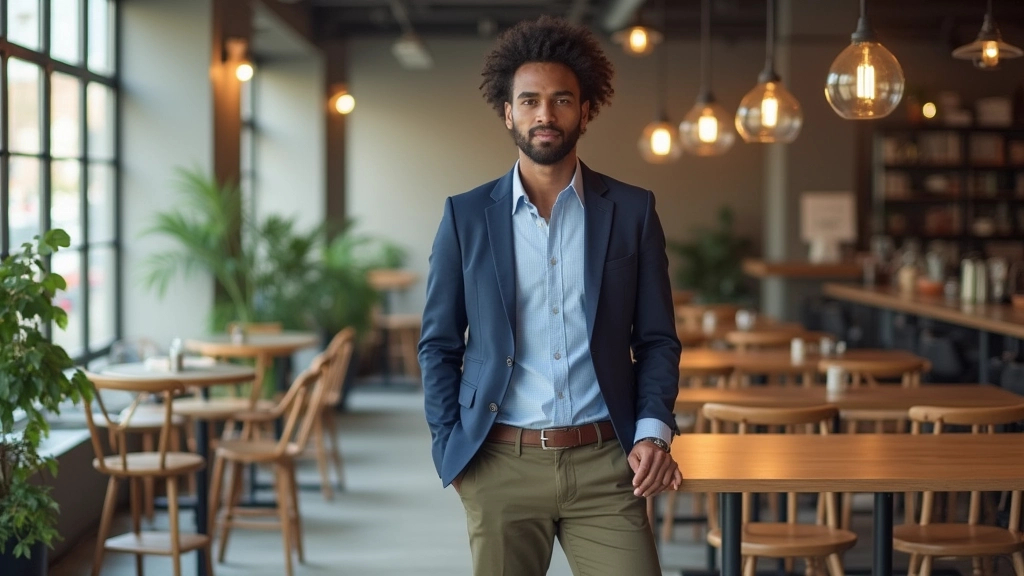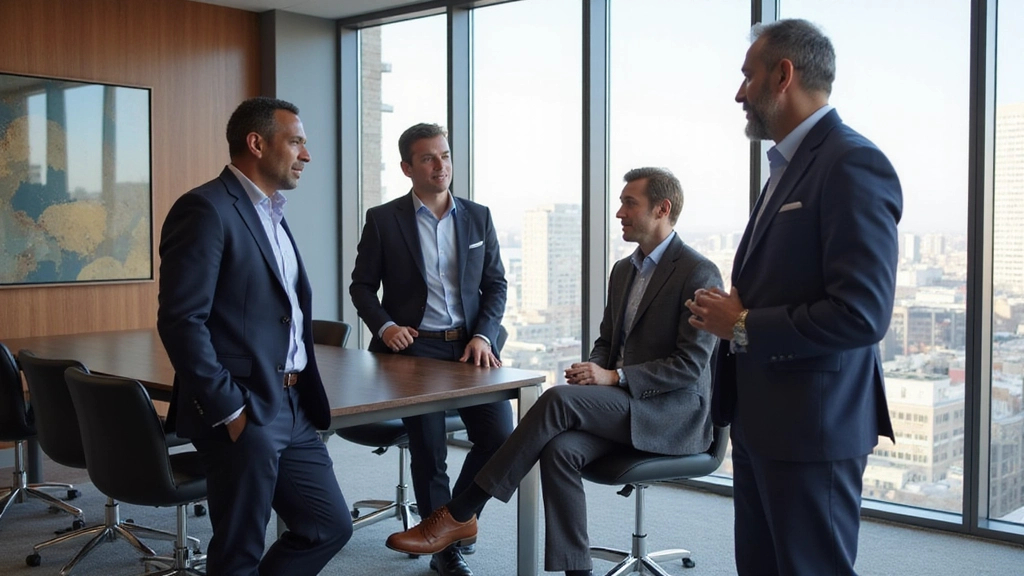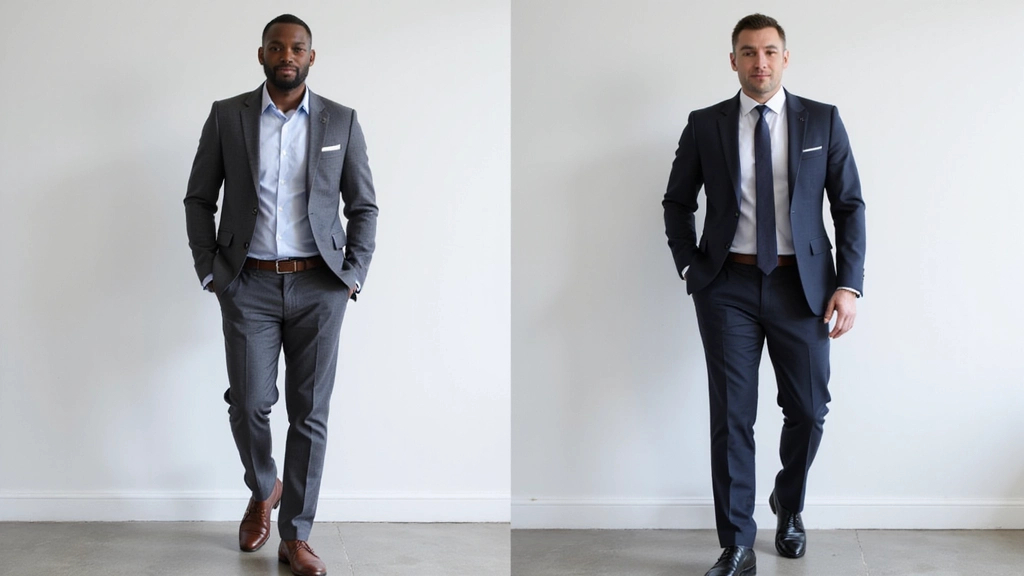“Business casual” might be the most confusing dress code in the modern workplace. One office calls it khakis and polos, while another expects tailored chinos and blazers. The truth? There’s no single answer because business casual isn’t a rigid rulebook. It’s a flexible spectrum that adapts to your environment.
For men navigating today’s diverse work settings, understanding what is business casual for men means recognizing that context is everything. The look that works for a tech startup’s casual Friday won’t cut it for a client presentation. That’s exactly the point.
We’re about to decode this puzzle once and for all. Instead of leaving you guessing what is considered business casual for men, we’ll show you five distinct levels of this dress code spectrum. Each level represents a different workplace vibe and professional context, giving you the confidence to nail the right look every time.
Think of it as your visual roadbook. From relaxed startup culture to elevated client-facing environments. By the end, you’ll know exactly where you fit on the business casual spectrum and have a clear business casual men starter pack for any situation that comes your way.
What is business casual for men?
Business casual for men strikes the perfect balance between professional polish and everyday comfort. It’s the dress code that bridges the gap between formal suiting and weekend wear. Smart enough for meetings, comfortable enough for long office days. What is considered business casual for men centers on clean lines, quality fit, and pieces that look intentional rather than thrown together.
Your business casual men starter pack should include tailored chinos or dress trousers in navy, charcoal, or khaki, paired with crisp button-down shirts or refined knit polos. Layer with unstructured blazers or lightweight cardigans when you need more presence. For footwear, think leather loafers, oxford lace-ups, or polished desert boots. Nothing too casual, nothing too formal.
The key to nailing what is business casual for men lies in fit and fabric quality. Well-tailored pieces in breathable materials like cotton, wool blends, or performance fabrics will serve you better than expensive items that don’t fit properly. Whether you’re shopping for affordable business casual men clothes or investing in premium pieces, prioritize modern or slim fits that create clean silhouettes while allowing comfortable movement throughout your workday.

The perfect business casual template
Building a versatile business casual wardrobe doesn’t require a massive closet. It needs smart planning. This streamlined template creates multiple outfits from just a few quality pieces, giving you flexibility to navigate everything from creative meetings to client presentations.
- Start with two bottoms: One pair of tailored chinos in navy or charcoal, plus dress trousers in a complementary neutral. These anchor your entire wardrobe and work across Levels 2-3.
- Add three versatile tops: A crisp white button-down, a refined knit polo in navy or gray, and a subtle patterned dress shirt. Each pairs seamlessly with both bottom options.
- Include one strategic layer: An unstructured blazer in charcoal or navy transforms any combination from Level 2 casual to Level 3 corporate-ready instantly.
- Choose two shoe options: Leather loafers for polished versatility and clean oxford sneakers for approachable professionalism. Both work with chinos. Dress shoes pair perfectly with trousers.
This framework generates 12+ different combinations from just 8 pieces. Mix chinos with the polo and sneakers for relaxed days, then switch to dress trousers, the button-down, and blazer for important meetings. The key is choosing pieces that complement each other across every possible combination. Your perfect business casual starter pack.
Level 1: The Startup Creative
This is where innovation meets comfort. You’re in a fast-paced, ideas-first environment where rigid dress codes feel as outdated as fax machines. The vibe here values substance over formality, but that doesn’t mean sloppy.
The formula is refreshingly simple: one part dark-wash denim, one part elevated casual top, and a pair of clean, modern sneakers. The key is in the details. Your jeans should be well-fitted and dark enough to look intentional, not accidental.
Start with premium dark-wash jeans that sit properly at your waist. Add a quality henley or crew-neck sweater in neutral tones like charcoal, navy, or forest green. Complete the look with minimalist white leather sneakers or sleek canvas options.
This level works because it communicates approachability while maintaining a polished edge. You’re saying “I’m creative and collaborative” without sacrificing professionalism. The affordable business casual men clothes at this level focus on quality basics that work hard across multiple contexts.

Level 2: The Flexible Professional
Welcome to the sweet spot of modern office dressing. This environment appreciates polish but doesn’t demand stuffiness. Think hybrid workplaces, creative agencies, or companies with “smart casual” policies.
Here’s your winning formula: tailored chinos become your foundation, topped with a crisp button-down or refined polo, finished with versatile footwear that bridges casual and formal. The magic happens in the fit and fabric choices.
Choose chinos in versatile colors like navy, olive, or khaki. Pair them with a well-fitted button-down shirt. White, light blue, or subtle patterns work beautifully. For footwear, think leather loafers, clean desert boots, or polished oxford sneakers.
Layer strategically with a lightweight cardigan or unstructured blazer when the situation calls for more presence. This level gives you flexibility to dress up or down within the same outfit framework.
The beauty of Level 2 lies in its adaptability. These pieces transition seamlessly from morning meetings to after-work events, making them essential components of any business casual men starter pack.

Level 3: The Corporate Casual
Step into the realm of established corporations that have embraced modern dress codes. This is where “business casual” gets more structured. You need to look the part while maintaining comfort and contemporary style.
The formula elevates significantly. Dress trousers replace chinos, dress shirts become non-negotiable, and your footwear steps firmly into leather territory. Optional blazers add instant authority when meetings matter.
Build around wool-blend dress trousers in charcoal, navy, or subtle patterns. Choose crisp dress shirts in classic colors. White, light blue, or refined stripes. Leather dress shoes are essential: think oxford lace-ups, refined loafers, or sleek monk straps.
A well-fitted blazer in navy or charcoal becomes your ace card. Remove it for approachable moments. Add it back for presentations or client interactions. The versatility gives you control over your professional presence throughout the day.
This level communicates competence and reliability. Qualities that matter in traditional business environments. When people ask what is business casual for men in corporate settings, this is often the answer they’re seeking.

Level 4: The Client-Facing Professional
You’re in the big leagues now. This level handles client meetings, important presentations, and situations where your appearance directly impacts business outcomes. Every detail matters because you’re representing not just yourself, but your entire organization.
The formula becomes more refined. Premium dress trousers, carefully selected dress shirts, quality leather shoes, and blazers that fit like they were made for you. Accessories start playing a supporting role. Watches, belts, and ties when appropriate.
Invest in superior dress trousers with impeccable tailoring. Choose dress shirts in premium fabrics. Crisp cotton or subtle textures that catch light beautifully. Your leather shoes should be investment pieces: classic oxfords, sophisticated brogues, or elegant loafers.
A collection of well-fitted blazers becomes crucial. Navy, charcoal, and perhaps a subtle pattern for variety. Quality accessories matter here. A refined leather belt, a classic watch, and occasional ties for elevated moments.
This level demonstrates expertise and attention to detail. When clients meet you, they see someone who takes their business seriously. It’s about building trust through consistent, polished presentation.

Level 5: The Executive Standard (Smart Business Casual)
This is what is smart business casual in its truest form. The most elevated expression of non-formal business dress. You’re in senior-level environments where leadership presence matters, but full suiting isn’t required daily.
The formula reaches its peak sophistication. Impeccably tailored separates that could easily be mistaken for suit components, premium materials, flawless fit, and accessories that whisper rather than shout quality.
Think luxury dress trousers in fine wool or wool-silk blends. Select dress shirts from premium business casual men clothing brands. Fabrics that feel as good as they look. Your blazers should be tailored to perfection, creating clean lines that enhance your silhouette.
Footwear becomes an investment category. Handcrafted leather shoes, perhaps bespoke or from heritage brands. Accessories are subtle but significant. Quality watches, refined cufflinks when appropriate, and leather goods that age beautifully.
Smart business casual represents the pinnacle of non-formal professional dressing. It’s about commanding respect through understated excellence. Every element works in harmony to create a look that’s both authoritative and approachable.
At this level, you’re not just dressed appropriately. You’re setting the standard for what professional excellence looks like in modern business environments.

Building Your Business Casual Foundation
Now that you understand the spectrum, building your wardrobe becomes strategic rather than overwhelming. Start by identifying which level matches your primary work environment, then build outward for flexibility.
For most professionals, Levels 2 and 3 provide the foundation you need. These pieces work together, giving you options without requiring massive investment. Focus on quality over quantity. Better to have fewer pieces that work perfectly than a closet full of mediocre options.
When shopping for affordable business casual men clothes, prioritize fit above everything else. A well-tailored $50 shirt looks better than a poorly fitted $150 one. Many business casual men clothing brands offer excellent options at various price points.
Consider your lifestyle beyond work too. The best business casual pieces transition seamlessly from office to dinner, from meetings to weekend plans. This versatility makes every purchase more valuable.
Business casual vs. smart casual
Business casual and smart casual serve different professional purposes. Business casual prioritizes office-appropriate structure. Think tailored chinos, button-down shirts, and leather loafers that work across meetings and daily tasks. Smart casual leans more relaxed with refined touches like dark jeans, knit polos, and premium sneakers for creative environments or after-hours networking.
The key contrasts: structure (business casual favors sharper lines), fabrics (business leans toward dress shirt cottons while smart casual embraces textured knits), footwear (leather dress shoes versus elevated casual options), and accessories (business casual welcomes blazers and watches, smart casual stays minimal). For office settings, business casual works in navy, charcoal, and white with tailored fits, while smart casual allows deeper colors and slightly relaxed silhouettes that still look intentional.

Business casual vs. business formal
Business formal takes the guesswork out of professional dressing. It’s structured suiting with clear rules. You’re looking at a matched suit, crisp dress shirt, tie, and polished leather dress shoes. Business casual gives you more flexibility with mix-and-match separates: tailored chinos or dress trousers, button-downs or polos, and leather shoes that don’t require a shine every morning.
The key difference lies in structure and formality. Business formal demands ties, while business casual makes them optional. Your shoe game shifts from oxfords and cap-toes to loafers and brogues. Fabric choices open up too. Business casual welcomes knits, textured weaves, and performance blends alongside traditional dress shirt materials.
Here’s when to level up: client meetings where first impressions matter, job interviews, presentations to senior leadership, or any situation where you’re representing your company externally. When in doubt, it’s easier to remove a tie or blazer than to wish you’d worn one. For most modern offices, business casual hits the sweet spot of looking polished without feeling overdressed.

Seasonal Business Casual
Seasonal business casual means adapting your office wardrobe to the weather while staying professional. Spring suggests light cotton-linen blends and stretch wool. Summer needs moisture-wicking fabrics and unstructured blazers. In fall, choose deeper colors and wool-blend trousers for easy transitions. Winter calls for warm, well-fitted coats over your blazer and versatile pieces you can mix and match.
Layer smartly. Start with a quality shirt, add a lightweight sweater or cardigan, and top with a tailored blazer. Leather oxfords and loafers suit all seasons, but switch to weather-resistant footwear in wet or cold months to stay polished.
Dressing for the season: Smart business casual year-round
- Spring: Opt for lighter fabrics, soft colors, and weather-ready loafers or suede boots.
- Summer: Wear breathable, moisture-wicking shirts and lighter shades. Canvas or perforated shoes are ideal.
- Fall: Layer with cardigans and unstructured blazers in rich tones. Leather boots add polish and grip.
- Winter: Choose wool-blend trousers, warm outerwear, and dress boots. Stick to deep neutral and winter white shades.
Do’s and don’ts of business casual
Getting business casual right means focusing on the fundamentals that elevate your look from casual to office-ready. The difference between looking polished and looking sloppy often comes down to a few key details.
Do’s:
- Choose well-tailored pieces that fit properly through the shoulders and chest
- Keep leather shoes clean and polished. They make or break the look
- Press your shirts and maintain crisp, clean lines
- Select quality fabrics like stretch wool, cotton blends, and refined knits
- Stick to versatile colors: midnight navy, charcoal, light blue, and khaki
- Pay attention to fit. Modern or slim cuts look more contemporary
Don’ts:
- Wear overly casual fabrics like jersey knits, athletic materials, or faded denim
- Choose loud graphics, busy patterns, or novelty prints
- Ignore proper fit. Too tight or too loose both look unprofessional
- Skip shoe care or wear scuffed, dirty footwear
- Mix too many patterns or colors in one outfit
- Forget grooming details: wrinkled clothes, loose threads, or missing buttons
Smart business casual is about looking intentionally dressed without being overdressed for your specific work environment.
The Confidence Factor
Business casual for men isn’t just about clothing. It’s about confidence and knowing what fits your work environment. When you understand which level of business casual suits your office, you eliminate guesswork, look appropriate, and can focus on your work instead of your outfit.
This flexible spectrum lets you adapt your style for any situation, from creative meetings to high-stakes presentations. The goal is to appear competent and reliable. Not flashy. By building a wardrobe of quality, versatile pieces matched to your primary level.
Master business casual by identifying the right level for your workplace, investing in well-fitted essentials, and letting your professionalism and expertise stand out. This strategic approach gives you confidence and presence in any professional setting.
Frequently asked questions
Prioritize tailored, modern fits over loose or baggy styles. Your chinos, dress shirts, and blazers should follow your silhouette without being restrictive. Clean lines matter more than tight fits.
Leather loafers, oxford lace-ups, and refined desert boots are reliable choices. Avoid athletic sneakers except in very casual environments. Polish and clean lines elevate any outfit.
Not always, but having one ready gives you flexibility. An unstructured navy or charcoal blazer instantly elevates your look for meetings or client interactions when needed.
Generally no. Business casual typically means no tie required, but having a few quality ties available helps you adapt to more formal moments or conservative environments.
Depends on your workplace culture. Dark-wash, well-fitted jeans work in creative or startup environments, but most traditional offices prefer chinos or dress trousers instead.
Subtle stripes, small checks, and refined textures work well. Avoid loud graphics or busy patterns. Think windowpane, herringbone, or simple plaids that complement rather than dominate your look.
Business casual varies widely. Tech companies lean casual while finance stays polished. Observe your colleagues and ask HR when in doubt. It’s better to be slightly overdressed than underdressed.
Navy chinos, a crisp white dress shirt, and leather loafers create a foundation that works anywhere. Add or remove layers like cardigans or blazers to match your environment.

